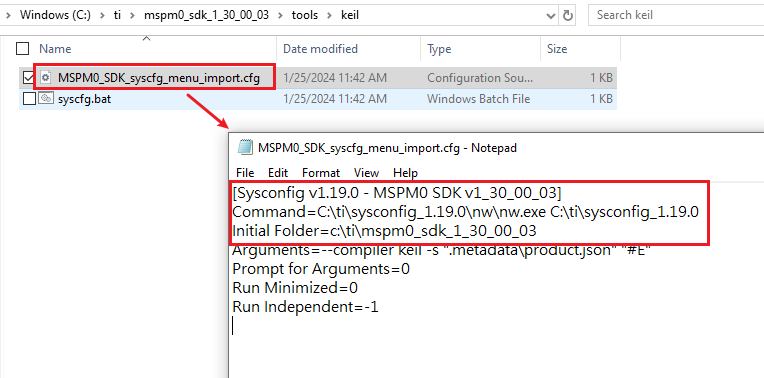SLAAED1D June 2023 – October 2024 MSPM0C1103 , MSPM0C1103-Q1 , MSPM0C1104 , MSPM0C1104-Q1 , MSPM0G1107 , MSPM0G1505 , MSPM0G1506 , MSPM0G1507 , MSPM0G1519 , MSPM0G3105 , MSPM0G3105-Q1 , MSPM0G3106 , MSPM0G3106-Q1 , MSPM0G3107 , MSPM0G3107-Q1 , MSPM0G3505 , MSPM0G3505-Q1 , MSPM0G3506 , MSPM0G3506-Q1 , MSPM0G3507 , MSPM0G3507-Q1 , MSPM0G3519 , MSPM0L1105 , MSPM0L1106 , MSPM0L1227 , MSPM0L1228 , MSPM0L1228-Q1 , MSPM0L1303 , MSPM0L1304 , MSPM0L1304-Q1 , MSPM0L1305 , MSPM0L1305-Q1 , MSPM0L1306 , MSPM0L1306-Q1 , MSPM0L1343 , MSPM0L1344 , MSPM0L1345 , MSPM0L1346 , MSPM0L2227 , MSPM0L2228 , MSPM0L2228-Q1
- 1
- Abstract
- Trademarks
- 1Overview
- 2Step 1: MSPM0 Selection
- 3Step 2: MSPM0 Evaluation
- 4Step 3: Hardware Design
- 5Step 4: Mass Production
- 6Step 5: Quality and Reliability Instructions
- 7Common Questions
- 8Additional Information
- 9Summary
- Revision History
3.4.3.1.2 Sysconfig Support Setup
If SysConfig is required, follow the steps below to enable use. Make sure that SysConfig and SDK are installed ahead. Here, we use SDK v1.30 and SysConfig v1.19 as an example.
- Navigate to the SDK folder (
...\ti\mspm0_sdk_x_xx_xx_xx\tools\keil). Edit SysConfig path in
syscfg.bat to match the downloaded standalone SysConfig address.
 Figure 3-42 Edit
syscfg.bat
Figure 3-42 Edit
syscfg.bat - In the same folder, open another
file for editing. Modify the SysConfig and SDK versions and paths.
 Figure 3-43 Edit
MSPM0_SDK_syscfg_menu_import.cfg
Figure 3-43 Edit
MSPM0_SDK_syscfg_menu_import.cfg - In Keil, select Tools →
Customize Tools Menu from the menu.
 Figure 3-44 Keil Customize
Tools
Figure 3-44 Keil Customize
Tools - Import
MSPM0_SDK_syscfg_menu_import.cfg file into the Customize Tools Menu.
 Figure 3-45 Import
MSPM0_SDK_syscfg_menu_import.cfg File
Figure 3-45 Import
MSPM0_SDK_syscfg_menu_import.cfg File - The SysConfig entrance now
appears on the menu. You can use SysConfig for MSPM0 development on Keil.
 Figure 3-46 Finish SysConfig
Setup
Figure 3-46 Finish SysConfig
Setup